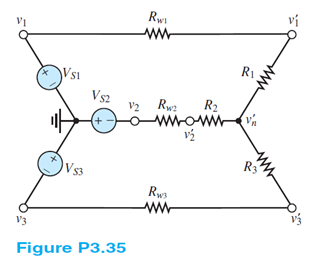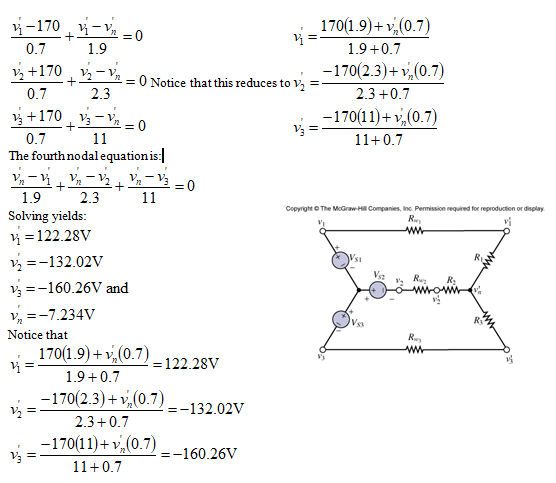The circuit shown in Figure P3.35 is a simplified DC version of an AC three-phase wye-wye (Y-Y) electrical distribution system commonly used to supply industrial loads, particularly rotating machines. a. Determine the number of non-reference nodes. b. Determine the number of unknown node voltages. c. Compute v'1, v'2, v'3, and v’n. Notice that once v’n is known the other unknown node voltages can be computed directly by voltage division.
VS1 = VS2 = VS3 = 170 V
Rw1 = Rw2 = Rw3 = 0.7?
R1 = 1.9? R2 = 2.3?
R3 = 11?

What will be an ideal response?
Known quantities:
The values of the voltage sources, , and the values of the 6 resistors in the circuit of Figure P3.35:
Find:
a. The number of non-reference nodes.
b. Number of unknown node voltages.
c. Compute v’1, v’2, v’3, and vn’.
Analysis:
a) The reference node is the node common to the three sources. There are seven (7) non-reference nodes: v1, v1’, v2, v2’, v3, v3’, and vn’.
b) The only unknown node voltages are v1’, v2’, v3’, & vn’. v1=VS1=170V, v2=-VS2=-170V, v3=-VS3=-170V.
A node analysis is the method of choice! Specify polarity of voltages and direction of currents.

You might also like to view...
In modulated current transfer, why is the explosive reestablishment of the arc softer, occurring over a very short period of time??
What will be an ideal response?
8 × (-10 ) =
A) -2 B) 80 C) -80 D) None of these
The timing function for shift operations of a shift register is provided by
A) the clock input. B) the shift pin. C) the D input. D) the Q outputs.
What is the purpose of diagnostic spoons?
A. To provide DMM probe contacts points while protecting pins and sockets. B. Provide a quick method to short out multiple pins. C. A tool to remove pins from connectors. D. Provide high impedance scope probe contacts.